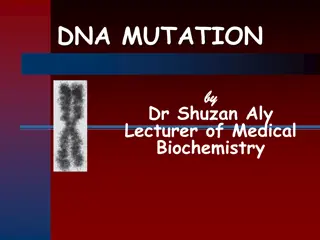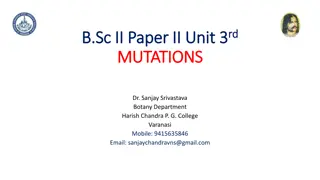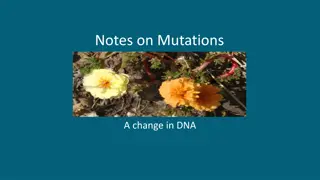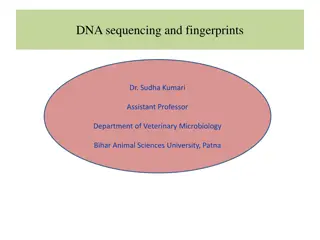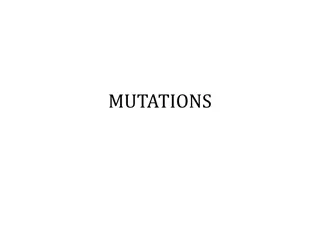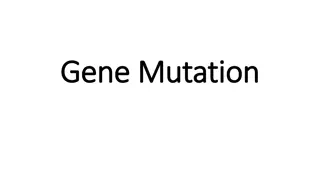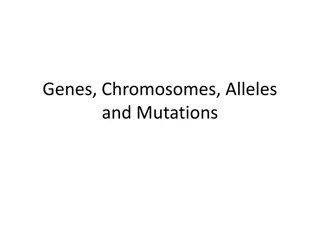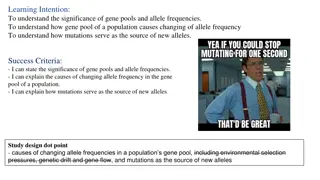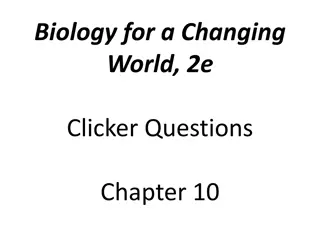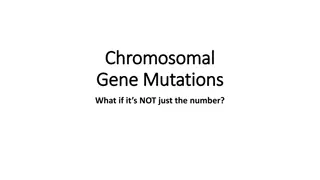Understanding Mutations and Their Effects on DNA
Learn about the structure of DNA, DNA replication, and various types of mutations such as substitution, deletion, and insertion. Explore how mutations occur, their effects at the molecular level, and how environmental factors can influence them. Discover the impact of mutations through examples of superheroes with genetic mutations and deepen your knowledge on this fundamental biological concept.
Download Presentation

Please find below an Image/Link to download the presentation.
The content on the website is provided AS IS for your information and personal use only. It may not be sold, licensed, or shared on other websites without obtaining consent from the author. Download presentation by click this link. If you encounter any issues during the download, it is possible that the publisher has removed the file from their server.
E N D
Presentation Transcript
HAPPY THURSDAY! 3/23 Remember, QUIZ TOMORROW over the structure of DNA and DNA Replication (NOT transcription/translation- that s Tuesday!) Self-assess HW (5 minutes) Mutation Notes (45 minutes)
Mutations Adapted from: National Science Foundation GK-12 and Research Experience for Teachers (RET) Programs, University of Houston https://www.teachengineering.org/lessons/view/uoh_mutations_lesson01
Superheroes How did Cyclops from the X-Men get his superpowers? He was born with the mutation How did the Hulk and Spiderman get their superpowers? The Hulk was exposed to gamma radiation and Spiderman was bitten by a radioactive spider
Learning about Mutations Types of mutations and how they occur How environmental factors influence mutations Effects of mutations
Types of Mutations Small-scale mutations Affect DNA at the molecular level by changing the normal sequence of nucleotide base pairs Occur during the process of DNA replications (either meiosis or mitosis) Normal DNA CAT AAG TAT CCT GTA Protein His Lys Tyr Pro Val
#1 Small-Scale Mutations 1. Substitution (or a point mutation ) Substitutions occur when a nucleotide is replaced with a different nucleotide in the DNA sequence This type of mutation only affects the codon for a single amino acid Substitution CAT AAG TAT CGT GTA Protein His Lys Tyr ARG Val
#2 Small-Scale Mutations 2. Deletion (a frameshift mutation) Deletion is the removal of a nucleotide from the DNA sequence Removal of even a single nucleotide from a gene alters every codon after the mutation Deletion C_TC AAG TAT CTA TA Protein Leu Arg Tyr Leu
#3 Small-Scale Mutations 3. Insertion (a frameshift mutation) Addition of a nucleotide to the DNA sequence Addition of even a single nucleotide to a gene alters every codon after the mutation Insertion CAT TAA A TAT CGC GGT Protein His Stop Tyr Arg Gly
Large-Scale Mutations Affect entire portions of the chromosome Some large-scale mutations affect only single chromosomes, others occur across nonhomologous pairs Entire genes or sets of genes are altered rather than only single nucleotides of the DNA Mutations involving multiple chromosomes are likely to occur in meiosis.
Large-Scale Mutations Nondisjunction Does not involve any errors in DNA replication or crossing-over Mutations occur when the chromosomes are not separated correctly into the new cells Common nondisjunctions are missing or extra chromosomes
Effects of Mutations The effects of mutations may range from nothing to the unviability of a cell All mutations affect the proteins that are created during protein synthesis, but not all mutations have a significant impact
Small-Scale Mutation Effects 1. Silent The nucleotide is replaced, but the codon still produces the same amino acid 2. Missense The codon now results in a different amino acid, which may or may not significantly alter the protein s function 3. Nonsense The codon now results in a stop command, truncating the protein at the location where the mutated codon is read; this almost always leads to a loss of protein functionality
Large-Scale Mutation Effects Often, large-scale mutations lead to cells that are not viable The cell dies due to the mutation
Mutation Influences Exposure to certain chemicals Carcinogenic chemicals may cause cancer Exposure to radiation Retroviruses Retroviruses such as HIV naturally experience mutations at a much higher rate than other organisms
Engineering Connection Humans have been genetically modifying plants and animals for thousands of years Example: Breeding watermelons to be larger and have fewer seeds Example: Breeding chickens to have more white meat and more breast meat
Engineering Connection Engineers can directly manipulate the genetic code of plants and animals (controversial) Examples: Disease-resistant papaya, vitamin A-rich rice, and drought-tolerant corn Engineers and scientists are currently studying gene editing in the womb May prevent the child from having diseases and disabilities


